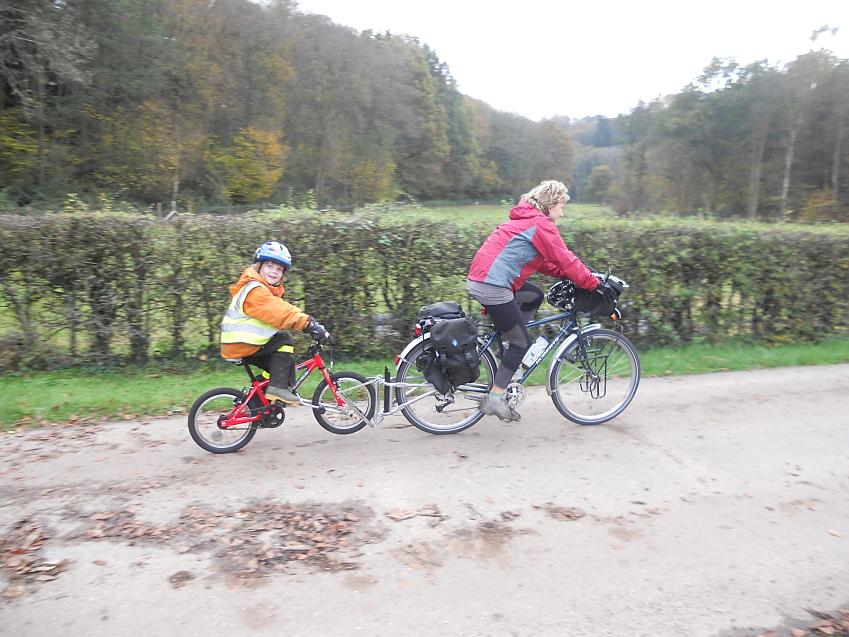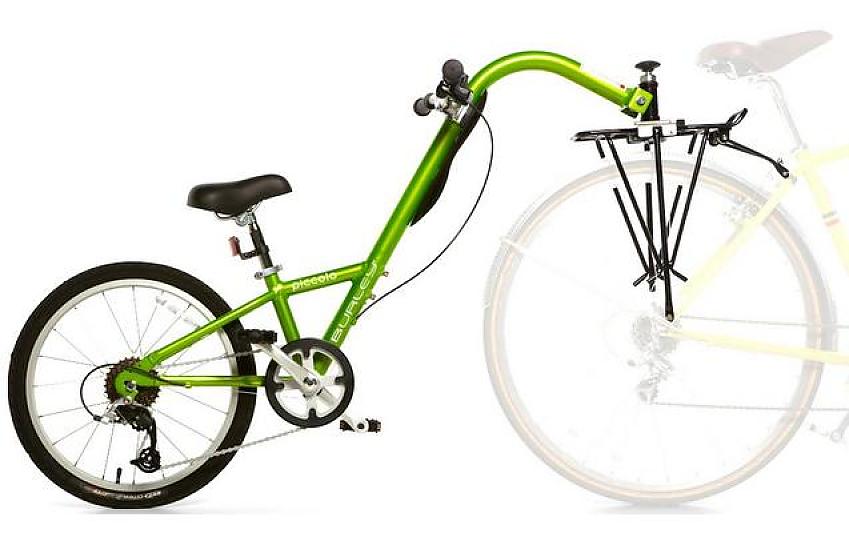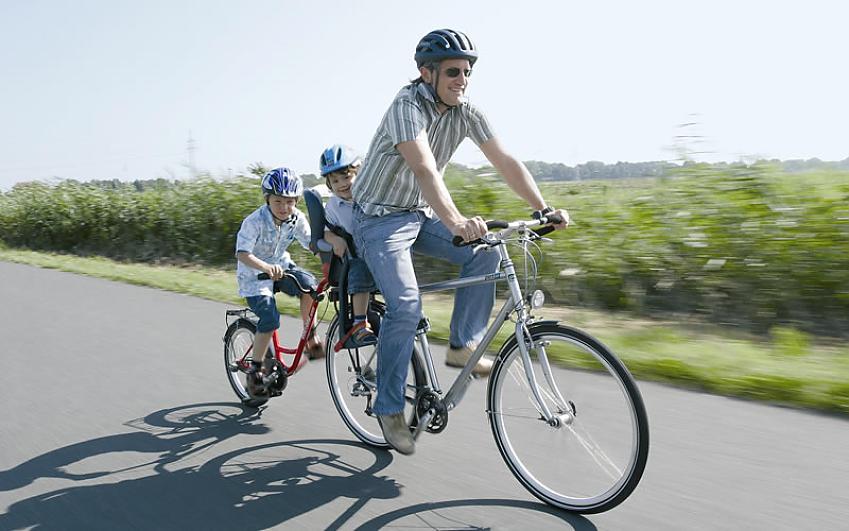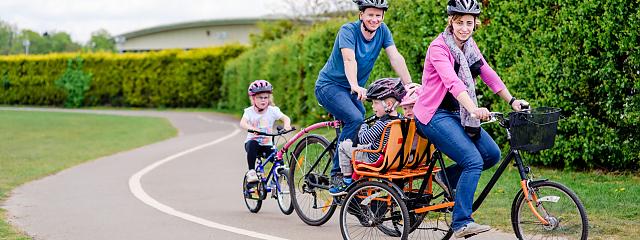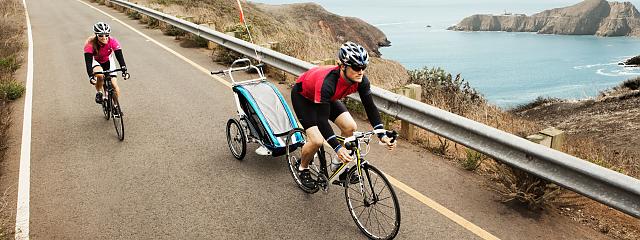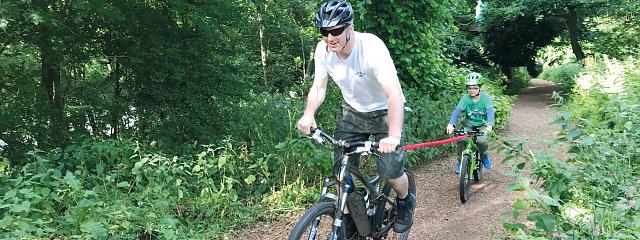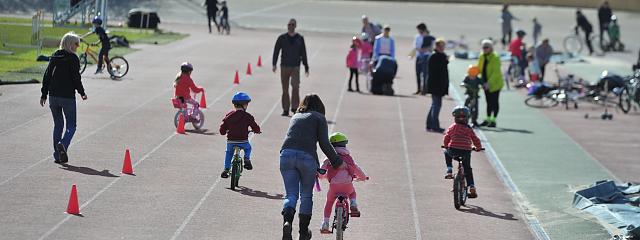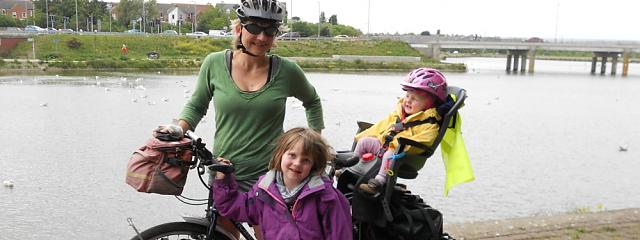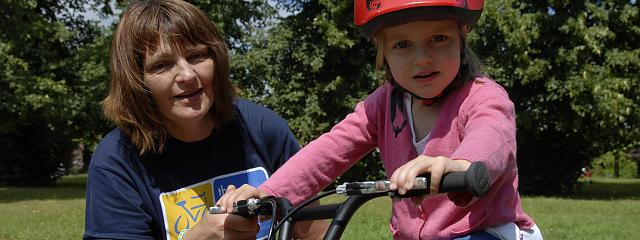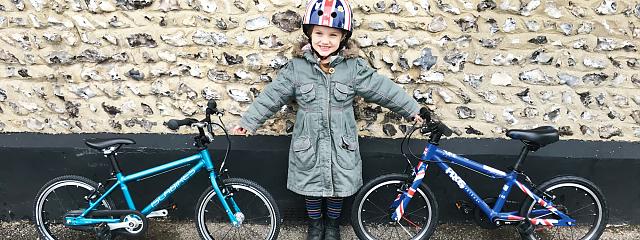
Guide to tag-a-longs
Guide to tag-a-longs
There comes the point in every cycling parent’s life when a child grows too big for the bike seat or trailer, but can’t manage longer rides yet. This is where a tag-a-long – also known as a trailer bike – comes in.
A tag-a-long bike is essentially a child’s bicycle with the front wheel, fork and headset replaced by a long towbar or boom. It fits to the back of an adult’s bike to form an articulated tandem.
You and your child can make trips that are faster, further and safer than you could manage on separate bikes. Your son or daughter can help out by pedalling or, when tired, can simply be towed along. Unlike most tandems, all trailer cycles have an independent freewheel.
We’d suggest this is an option is for a child who is 4 years or above, has good balance and can confidently use a pedal bike (without stabilisers). They will need to be mature enough to understand they cannot just climb off the trailer bike when they want to. This is especially important if you are cycling on the road.
Trailer cycles are much cheaper than tandems and take up much less space. They’re more versatile, too, in that you can detach the trailer cycle and use your bike as normal when required.
The trailer cycle has been around since the 1930s, when it was invented in England by Bill Rann. Recently it’s enjoyed something of a renaissance, although with a few notable exceptions the modern versions are actually worse than the Rann trailers of yesteryear.
That’s because most modern trailer cycles attach to and pivot at the seatpost. A much better arrangement, used by Rann in the past and by Burley and Islabikes today, has the trailer cycle’s vertical (pitch) and horizontal (turn) pivots directly above the towing bike’s rear axle. To attach here such designs use a rear rack that’s like, and often doubles as, a pannier rack.
All one-wheeled trailer cycles will cope with gentle off-road terrain and all can be taken touring. Most bikes can tow a trailer cycle. Only those that will accept a standard rear carrier rack can tow rack-mounted trailer cycles. Such bikes are a good choice in any case because they’re designed be ridden with a load. Bikes that aren’t, such as road bikes and most folding bikes, can handle very poorly when you add on a trailer cycle.
Trailer cycle designs
Most trailer cycles have one wheel. Some have two and look like the back end of a tricycle. Meanwhile, towbars have none.
Towbars
TrailGator – a towbar that fixes to your child’s existing bike to turn it into an ersatz trailer cycle. The attachment process locks out the steering on the child’s bike and may involve removal of the front wheel. It’s a versatile solution because you can convert a trailer cycle to a child’s bike, or vice-versa, mid-ride.
In practice, bike handling is much the same as with other seatpost-mounted trailer cycles – just about adequate. It isn’t as sturdy, but it is cheaper.
FollowMe Tandem – a Swiss-designed, rear-axle mounted trailer that lets you bring your child’s own bike along so they can ride separately if they wish. It’s mostly made of steel, but only adds 4kg to the bike’s normal weight.
If you have an Islabike you will need to order the Islabike version. This is because since the end of 2013 the Cnoc 14 and Cnoc 16 have wheels with hollow bolt through axles.
Josie Dew, Cycling UK’s vice president, uses a FollowMe Tandem when cycling with her daughter Molly. She said on her website: “When Molly wants to cycle her bike under her own steam she can, but when she tires or the road gets busy, I can hook her up to the FollowMe (which sits on the back of my bike) and she follows me, in fine and frolicking tandem fashion.”
Single wheel tag-a-longs
Single wheel trailer cycles come in two types: seatpost or rack mounted.
Seatpost-mounted tag-a-longs
Most single-wheel tag-a-longs attach at the seatpost because that design is cheap and easy to make. The trailer cycle articulates on plain bearings.
At best, the turn pivot is vertical and on a bracket that’s behind the seatpost; at worst, the turn pivot is the seatpost. Since a bike’s seatpost isn’t vertical (it’s around 72 degrees rather than 90), this leads to a peculiar handling quirk in which the trailer cycle leans out on corners.
Handling problems are compounded by the plain bearings: there’s a fine line between too tight, which means the trailer won’t articulate properly, and too loose, which gives slop or play at the joint, letting the trailer cycle rock from side to side. This feels like someone grabbing hold of the seatpost of your bike and trying to twist it from side to side. So you need to set up seatpost hitches with care.
Rack-fixing trailer cycles
Rack-fixing trailer cycles are somewhat more rare. The Burley Piccolo (which was tested in Cycle magazine in 2012) has been the benchmark for some years thanks to its excellent handling.
Not only does the Piccolo have the pivots above the towing bike’s rear axle, like the Rann, it improved on the design. The turn pivot is fixed to the rack, with the pitch (vertical) pivot behind it on the towing arm. This stops the trailer cycle flopping or jackknifing when it’s being pushed along on foot.
Alternatively, there’s the Roland Add+Bike 1-speed, the only other rack-fitting trailer bike we can find. The rearward hitch allows a child bike seat on the tow bike.
Trailer tricycles
Tag-a-longs with two rear wheels – trailer tricycles, if you like – are heavier and more awkward to store than single wheelers but are much better for heavier loads.
With a single-wheel trailer cycle, you’re ill advised to ride with a child more than half your own weight because the twisting forces that the trailer cyclist exerts on the towing bike can upset the steering. A trailer tricycle won’t tip the towing bike’s balance like this because it doesn’t lean; it’s always upright.
If your rider has additional needs, you may want to consider an adapted cycle. You can try these out at an inclusive cycling centre near you.
Understanding handling
Even the best trailer cycle doesn’t ride as surely as a good tandem. Partly it’s because the bit doing the steering – your bike – has a shorter wheelbase than a tandem, combined with steering geometry that’s optimised for a solo bicycle.
Mostly, however, it’s because the bike-plus-trailer cycle articulates and you’ve got a weight behind you that can twist, tug and shunt the towing bike at the attachment point. So the better the attachment point is designed, the better the overall handling will be.
Rack-mounted trailer cycles handle much better than seatpost-mounted ones. Instead of pivoting on plain bearings they can take advantage of ball bearings so that they turn as sweetly as the headset on your own bike, moving freely but without play.
The attachment point of a rack-mounted trailer cycle is right above the towing bike’s rear axle rather than in front of it, so it tracks better after the towing bike instead of cutting corners. Effectively the attachment point is a bit lower down, too: it’s connected, via the carrier rack, to the towing bike’s seat stays and rear dropouts. That means the trailer cycle has less leverage to tug at the towing bike.
With a relatively light passenger, seatpost-mounted trailer cycles can nevertheless handle adequately for cycle tracks and the like. Things get erratic when the hitch has too much play or the passenger is too heavy. Just riding along on a flat road suddenly becomes a trial.
This is why it’s a bad idea to have a single-wheel trailer cycle for two passengers. Bike handling isn’t just bad, it’s dangerous. You don’t see many two-seaters like this around, but Adams used to make one.
Dan Joyce warns: "If you do see one second hand, avoid it. In the decades working as a cycle journalist it’s the most dangerous thing I’ve ever taken out on the road."
Trailer tricycles are a different matter. Balance isn’t a problem, even with two passengers or a heavier load, because the trailer part doesn’t lean-steer.
A seatpost hitch is fine, so long as the turn pivot is vertical rather than parallel to the seatpost. Ideally you want some kind of ball joint rather than a universal joint, so that the bicycle (towing bike) and tricycle (trailer cycle) can corner without the bicycle trying to make the tricycle lean – something it can only do with one wheel in the air!
The difference in cornering between towing bike and trailer tricycle is not a problem at modest speeds – say, 15mph and below. It is a problem if you hit a corner going faster, especially if it’s off-camber. Trailer tricycle passengers must lean into the corner or the trailer cycle may roll out of the corner onto its side.
Similarly, it’s easy to flip an unoccupied trailer tricycle if it clips a kerb at speed. If you ride with a degree of restraint, everything will be fine without any motorcycle-sidecar-style leaning. You can, of course, remove any handling disparities by coupling a trailer tricycle to the back of a tricycle.
Note that a trailer tricycle may try to twist around the towbar, assuming it’s fixed to a bicycle without the use of a ball joint, so you also need to make sure any bolts between trailer cycle frame and towbar are done up tightly.
Useful extras
Most trailer cycles can be detached in seconds without tools, leaving the hitch or rack on the towing bike. If you buy an extra rack or hitch, you can readily swap the trailer cycle between bikes. So, for example, if you wanted to use a trailer cycle for the school run, one parent could drop off, the other pick up. The trailer cycle could be locked up at or near school in the interim.
Whatever attachment the trailer cycle uses, ease of removal must not compromise security. The hitch must not be able to come off the bike, or the towing arm from the hitch, by itself. Even if a quick-release comes loose, there should be some failsafe to stop it detaching instantly.
The use-life of your trailer cycle will be longer if it can accommodate a growing child. Some have handlebars that can be clamped further up the frame to suit a bigger child. You can also raise the saddle on any trailer cycle.
If you’re intending to use one for children of different sizes – for example, sometimes carrying your five-year-old, sometimes your seven-year-old – then it makes sense to fit a quick-release seat binder bolt. This will enable you to adjust saddle height for each journey.
Gears
Six- or seven-speed gears don’t add much to the cost of a trailer cycle and are well worth having. Your passenger can contribute more to the ride by pedalling on the flat and uphill. It’s good practice for a child’s own bike, too.
If you get a single speed, the gear needs to be fairly low so that your child can help you by putting some power in when you most need it: going uphill.
Cycling UK's Victoria Hazael pointed out: “At four my son was rather distracted by playing with the gears and found a single speed tag-a-long easier. Now he’s older and heavier the gears are a real help, especially uphill.”
Brakes
A brake isn’t necessary for the trailer cycle and could even be dangerous. Used at the wrong time, such as when you’re not braking, the trailer cycle would skid.
Your bike’s brakes must be good, although you need to apply them progressively rather than suddenly if you’re going down a steep hill, as the trailer cycle can shunt the towing bike.
However, if you’re attaching a trailer cycle to the back of an already heavy bike, such as a tandem, it’s worth adding a drag brake to the towing bike to help keep your speed under control during any long descents.
Mudguards
Make sure the towing bike has a rear mudguard, ideally with a mudflap, otherwise you’ll spray road run-off into the face of your passenger. If there isn’t a mudflap, fit a mountain bike-style down tube guard to the trailer cycle. The trailer cycle itself needs a mudguard too.
Lights
If you go out at night, it must also be fitted with a red reflector and a red rear light in order to comply with traffic law.
Tyres
A slick or semi-slick tyre is better for the trailer cycle than a knobbly one, unless you really will be spending most off your time riding off road. The lack of tread will enable it to roll easier.
Toe clips
Toe clips are useful to keep your child’s feet on the pedals. That’s better for balance and for fast pedalling, although it’s not as important as it would be on a tandem.
A child can freewheel independently on a trailer cycle, so there isn’t the risk that flailing legs will get whacked by pedals that you’re still cranking round.
Size
Some trailer cycles fold along the towbar or around the seat tube. This is handy for storage, especially in the back of car, although it will probably be too big to carry onto a train as luggage. Be prepared to book it on a train as a full-size bicycle instead.
Mirror
A mirror lets you keep an eye on your passenger and on following traffic, as it does with a child seat.
Panniers
You can usually put panniers on the towing bike when you’re using a trailer cycle. It’s unwise to put them on the trailer cycle itself, because the added weight there will compromise bike handling just as if you were towing a heavier child. Trailer tricycles are an exception and will easily carry a hamper-sized load between the rear wheels, given a suitable rack.
With a tandem
You can tow a trailer cycle behind a tandem even more easily than you can behind a solo bicycle. It upsets the handling less, because the trailer cycle passenger is a smaller fraction of the weight that’s on the towing bicycle.
If you want to use a child-back tandem to tow a trailer cycle, you’ll need to use a rack-mounted model. That’s because the child’s seat – and hence, seatpost – will be so low down that the rear wheel will get in the way of a seatpost-mounted towing arm.
With a child bike seat
You can’t usually ride with a rear child seat and a trailer cycle attached to the same bike. It is possible with the Roland Add+bike, which attaches the trailer cycle to the very back of a custom rack.
From a handling point of view, this is worse than having the pivot above the towing bike’s rear axle, but it’s not much further back and hence not much worse – and if you want trailer cycle plus child seat it’s a compromise you’ll need to make. It’s still better than a seatpost hitch.
On the subject of child seats: don’t put one on the actual trailer cycle unless it’s in place of, rather than as well as, the existing seat. Trailer tricycles work best for this.
How to help a child use a tag-a-long
Whatever kind of trailer cycle you use, you should instruct your co-rider to stay seated. The side-to-side lurch from your passenger pedalling while standing up will severely affect your steering.
Most of the time you won’t get that much help in powering along. Yet when your co-rider does pedal in earnest, you will feel it and it does make a difference.
Do say how much you appreciate the help – it’s good for their morale. Your child won’t be able to keep pedalling hard for very long, so if you’re on a big ride encourage him or her to conserve energy. Call for help when you see that hill ahead with a casual: “Time for a turbo boost!”
Be aware that on longer rides your child will tire before you do, even though you’re doing most of the work. Check morale and energy levels regularly by keeping a conversation going, and if necessary boost both with stops and snacks.
Adults can feel themselves getting more tired; children can conk out in moments and suddenly be upset and tearful. Our guide to going on a bike ride with children has some useful tips.
Watch out, children can even fall fast asleep as they’re being towed along. On a trailer cycle, if they fall asleep they generally fall off. Tag-along trailers are a good alternative.
Is a tag-a-long or tow bar the right choice for you?
As with all decisions regarding transporting children by bike, you will need to consider:
- How heavy is your child?
- How good at balancing and cycling is your child?
- Where will you cycle?
- How long you will cycle for?
- How tired your child gets and will they need a nap?
- How much luggage will you be transporting?
- How much space do you have to securely store your bike and accessories, and do they need to be transported by car? (If space is a problem the FollowMe Tandem is the smallest option.)
- How much money you want to spend? If you budget is limited you canbuy good-quality second-hand bikes, trailers and tag-a-longs on the Cycling UK forum. Good trailer cycles such as Burleys hold their value well, so you may struggle to find a bargain second hand. The flip side is that you should get a good price for yours when your children finally outgrow it.
There are lots of ways to transport children by bike, other options you should consider are using a bike trailer, cargo bike or tandem.
It’s always best to try before you buy, ask around your local cycling group or club to see if you and your child can have a go using a tag-a-long. Alternatively, visit a bike hire centre.






